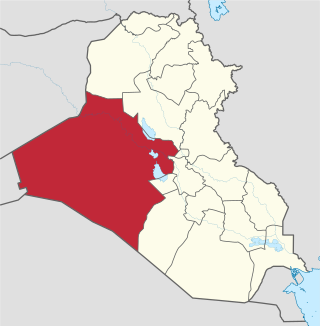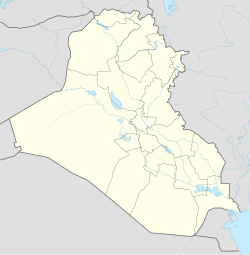
Al Anbar Governorate, or Anbar Province, is the largest governorate in Iraq by area. Encompassing much of the country's western territory, it shares borders with Syria, Jordan, and Saudi Arabia. The population is mostly Sunni Arabs. The provincial capital is Ramadi; other important cities include Fallujah, Al-Qa'im and Haditha.

Haditha is a town in the Al Anbar Governorate, about 240 km (150 mi) northwest of Baghdad. It is a farming town situated on the Euphrates River. Its population of around 46,500 people, predominantly Sunni Muslim Arabs. The town lies near the Buhayrat al Qadisiyyah, an artificial lake which was created by the building of the Haditha Dam, the largest hydroelectric facility in Iraq.

The Haditha massacre was a series of killings on November 19, 2005, in which a group of United States marines killed 25 unarmed Iraqi civilians. The killings occurred in the city of Haditha in Iraq's western province of Al Anbar. Among the dead were men, women, elderly people and children as young as three years old, who were shot multiple times at close range. The massacre took place after an improvised explosive device (IED) exploded near a convoy, killing a lance corporal and severely injuring two other marines. In response the marines executed five men from a nearby taxicab and 19 others inside four nearby homes.

The Haditha Dam or Qadisiya Dam is an earth-fill dam on the Euphrates, north of Haditha (Iraq), creating Lake Qadisiyah. The dam is just over 9 kilometres (5.6 mi) long and 57 metres (187 ft) high. The purpose of the dam is to generate hydroelectricity, regulate the flow of the Euphrates and provide water for irrigation. It is the second-largest hydroelectric contributor to the power system in Iraq behind the Mosul Dam.

A man-made reservoir in Al-Anbar, Iraq, Lake Qadisiyah sits on the north side of the Haditha Dam.

Multi-National Forces West (MNF-W) or United States Forces West (USF-W) was one of the coalition headquarters under Multi-National Force-Iraq. It was headquartered by either I or II U.S. Marine Expeditionary Force that rotated on a 12-month basis. Their area of operations was primarily the Al Anbar province which includes the cities of Ar Ramadi, Fallujah, Al-Qa'im, and Haditha. The force was the most important U.S. unit to take part in the Iraq War in Al Anbar Governorate.
The University of Anbar is an Iraqi university in Ramadi, Al Anbar, Iraq. It was founded in 1987 with a college of education and a college of girls' education, and then expanded until it reached university status in 2011 with 18 colleges. These colleges including 66 scientific departments, in addition to 6 Research Centers.

The Anbar campaign consisted of fighting between the United States military, together with Iraqi security forces, and Sunni insurgents in the western Iraqi governorate of Al Anbar. The Iraq War lasted from 2003 to 2011, but the majority of the fighting and counterinsurgency campaign in Anbar took place between April 2004 and September 2007. Although the fighting initially featured heavy urban warfare primarily between insurgents and U.S. Marines, insurgents in later years focused on ambushing the American and Iraqi security forces with improvised explosive devices (IEDs), large scale attacks on combat outposts, and car bombings. Almost 9,000 Iraqis and 1,335 Americans were killed in the campaign, many in the Euphrates River Valley and the Sunni Triangle around the cities of Fallujah and Ramadi.

Operation Al Majid was an operation conducted by both Marines and Iraqi security forces intended to disrupt and defeat insurgent activity throughout more than 30,000 square miles (78,000 km2) in western Al Anbar Province. The operation began in the fall of 2006 and resulted in a series of berms being constructed around the cities of Anah, Haditha, Haqlaniyah, and Barwanah.
In 2009, following the withdrawal of US forces from Iraqi cities on 30 June, a campaign of car bomb attacks was conducted throughout Anbar Governorate. In early 2009, U.S. forces began pulling out of cities across the country, turning over the task of maintaining security to the Iraqi Army, police, and their paramilitary allies. Experts and many Iraqis worried that in the absence of U.S. soldiers, AQI might resurface and attempt mass-casualty attacks to destabilize the country. There was indeed a spike in the number of suicide attacks, and through mid and late 2009, al-Qaeda in Iraq rebounded in strength and appeared to be launching a concerted effort to cripple the Iraqi government.

Operation Sayeed also known as Operation Hunter in English, was a series of operations conducted in western Al Anbar Governorate by the United States Marine Corps in 2005. It was an umbrella operation, consisting of at least 11 named operations between July 2005 to December 2005. The purpose was to drive Al-Qaeda in Iraq forces from the Western Euphrates River Valley. Some parts of Operation Sayeed were Operation Steel Curtain and Operation Iron Fist.
Hdatta or Haditha, was a historical city on the East bank of the Tigris just below its confluence with the Upper Zab. The city flourished during the Sasanian and early Islamic periods.
Haditha is a city in Iraq.

Beginning in December 2012, Sunnis in Iraq protested against the Maliki government. On 28 December 2013, a Sunni MP named Ahmed al-Alwani was arrested in a raid on his home in Ramadi. Alwani was a prominent supporter of the anti-government protests. This incident led to violence in Al Anbar Governorate between the Iraqi Army and a loose alliance of tribal militias and other groups fighting alongside the Islamic State of Iraq and the Levant (ISIL).

The Fall of Hīt was the capture of the important Iraqi town of Hīt by ISIL, which cut off the road leading to nearby Haditha.

The Al-Karmah offensive, codenamed Fajr al-Karma, was an offensive launched by the Iraqi Army and anti-ISIL Sunni tribal fighters to recapture the Al-Karmah district taken by the Islamic State of Iraq and the Levant in Iraq. The offensive began on 14 April 2015. During the offensive the anti-ISIL forces captured part of the city of Al-Karmah, and the old road of Al-Karmah.

Wadi Hauran is the longest wadi in Iraq. Located in Al Anbar Governorate west of Iraq, at Latitude 33.0333°, Longitude 40.2500° it's roughly midway between Damascus and Baghdad near the town of Rutba, it stretches for 350 kilometres (220 mi) from the Iraq–Saudi border to the Euphrates river near Haditha.

The Hīt shooting occurred on 30 October 2014 when insurgents from the Islamic State of Iraq and the Levant (ISIL) killed at least 75 members of the Albu Nimr tribe in Hīt, a town in Al Anbar Governorate.
The Battle of Hit, code named Operation Desert Lynx by Iraqi forces, was an offensive launched by the Iraqi Government during the Anbar offensive, with the goal of recapturing the town of Hīt and the Hīt District from ISIL. After the Iraqi forces recaptured the city of Ramadi, Hīt and Fallujah were the only cities still under the control of ISIL in the Al Anbar Governorate. Iraqi Forces fully recaptured Hīt and the rest of the Hīt District on 14 April 2016.












